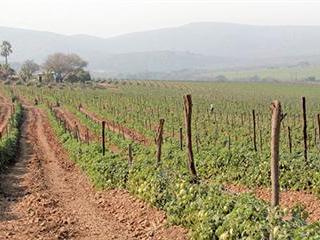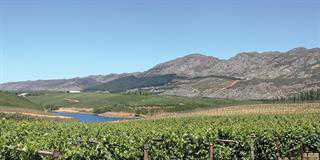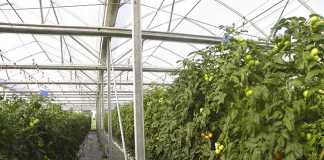
At the height of summer, temperatures can reach a sweltering 50°C in parts of the Pongola valley, 10km from the Swaziland border in northern KwaZulu-Natal. Because of the heat, high humidity and rain, fruit and vegetable crops suffer from heat stress and a range of diseases. Tomatoes are especially difficult to grow, being susceptible to bacterial wilt and phytophthora root rot, and many farmers shy away from growing them during the peak summer months of January and February.
The Terblanche family, however, has developed a programme to grow tomatoes all year round. With sugarcane as the primary crop, the tomato sideline ensures income when sugarcane does not, and acts as a successful rotation and pioneer crop. “When other growers can’t produce them, we have them. Demand is very high and so is the price,” says Sakkie Terblanche Jr, who manages the tomato production.
Some 128ha of the 400ha farm is devoted to the fruit. Sakkie Terblanche Sr and his sons Dallie and André oversee the 272ha sugarcane, while daughter Diana runs the packhouse.The key factors that enable them to grow tomatoes year-round are cultivar selection, irrigation and planting tomatoes on virgin soil in summer.
“We try to buy new land which isn’t planted to sugarcane because sugarcane lands are very expensive. We clear virgin soil for tomatoes and, after two or three years, when the disease pressure becomes too great, we apply for a quota from Pongola Mill to grow sugarcane on those lands,” explains Sakkie.

André and Sakkie Terblanche (centre) with children André Jr (left), Diana (second left), Dallie (centre back) and Sakkie Jr (right).
Labour-intensive
Planting tomatoes on virgin soil is labour-intensive, as bush must be cleared, stones removed, beds formed and trellises installed for the vines. Drip irrigation pipes must also be laid on the surface. Once the seedlings are planted, fertiliser is applied by hand alongside each plant in the row and closed up with a hand hoe. After two or three tomato crops, the land is cleared in a first-in, first-out order, and the trellis system is removed.
“It’s a long and arduous process, but it prepares the soil for our primary crop and spearheads our sugarcane expansion,” says Sakkie. “We’re growing all the time. In 2012, we bought a 100ha farm which is currently being cleared for tomatoes. But a time will come when all the land in Pongola is covered by sugarcane and we might have a problem expanding.” Every four weeks, 10ha of tomatoes are planted, using seedlings supplied by CPS Seedlings Pongola. Two varieties are planted – round and saladette. These have proven to be resistant to bacterial wilt.
Crop rotation
Tomatoes are also grown as a rotation crop with sugarcane. The average cane yield is 114t/ ha and cane lasts for eight to 10 ratoons. “As soon as the yield drops below 80t/ha, we consider putting in tomatoes, because the high cost of water and electricity erodes cane profitability,” explains Sakkie. “By that time, the soil has also been depleted of nutrients, but that’s easily rectified.
“The sugarcane that follows a tomato crop receives all the benefits of the fertiliser that we put into the ground.” Sakkie does not practise composting, nor does he base fertiliser applications on soil analysis. “We’re in the lands all the time and can tell by the colour and the plant growth when there’s a shortage of a nutrient,” he says. “I follow a standard chemical fertiliser programme and have no problems with the soil. A farmer’s footsteps on his land are as good as fertiliser for the plants.”
He employs a weekly spray programme for diseases and pests such as bollworm, looper, leaf miner, red spider mite and white fly. And a 2,5m inter-row spacing enables tractors to move through the land and spray with ease. “We spray every day to cover the entire crop weekly. If we’re not on top of white fly, it’ll take out almost all the tomatoes,” says Sakkie.
Despite regular spraying, he has not had problems with resistance. “We follow a block spray programme and don’t repeat a chemical more than two or three times,” he explains. “We spray very lightly and use softer chemicals. If we need to fix a serious problem quickly, we might come in with the red label stuff, but then we revert to lighter chemicals.” Pongola receives 650mm to 700mm rain annually, with about 445mm falling in the rainy months of November to February.
Not more than about 200mm of this summer rainfall is effective, however, as the soil can only absorb so much before the rest is lost to runoff or evaporation. Farmers generally do not rely on rainfall, thanks to an extensive irrigation and canal system built in the 1930s to supply water from the Bivane Dam. The dam is currently 84% full, which should be sufficient for two to three seasons, even if no rain falls. Only in cases of extreme and prolonged drought is a water shortfall experienced in Pongola.
“We have sufficient water in the valley, but it’s expensive at R2 500/ha/year. We irrigate for two to three hours every second day, although on exceptionally hot days we irrigate every day for two hours. Over-irrigating triggers bacterial wilt or phytophthora, so we try not to irrigate too much,” says Sakkie.As with fertiliser, water application is managed by eye on the land.
Costs
Growing tomatoes is not cheap. Sakkie estimates that seedlings alone cost about R8 500/ha. Then there are costs such as labour, trellises and twine. Sakkie jokes that if they had known the true cost of growing tomatoes, they would probably not have started. Tomatoes yield about 100t/ha in summer and up to 120t/ha in winter. “In summer, we start picking eight to 10 weeks after planting, and in winter at 12 to 14 weeks, and we sometimes pick on three or four 10ha lands simultaneously,” explains Sakkie. “We try to pick for as long as we can, sometimes up to 45 weeks, before the old plants are removed. Extending the crop life makes a big difference to profitability. That’s when we make money.”
Tomatoes are marketed under the family’s Basaki Tomatoes brand and sold off the farm to traders operating in markets in Mkuze, Paulpietersberg, Vryheid and elsewhere. A packhouse built in 2006 houses a Greefa computerised sorting machine that grades tomatoes by colour and weight at around 4t/hour. The farm also grows a small amount of peppers that go through the machine’s washing and drying facility. The hardworking Greefa does the work of 20 people, reducing packhouse staff from 30 to 10.
“To offset the higher wage bill, we’ve had to become more efficient in both the packhouse and the lands,” says Sakkie. “Previously we had 40 pickers who were paid the minimum wage. Now we’ve introduced a ticket system and pickers are paid per crate picked. “The best picker fills 55 crates a day, compared with an average of 37 crates under the minimum wage. “We pick 1 000 crates a day with 20 pickers. This incentive system has improved productivity.”
With an investment in a powerful John Deere 3520 mechanical harvester and trailers, mechanisation is also underway in the farm’s cane division. “Along with diesel, labour is our biggest cost increase. It’s one of the reasons for mechanising,” says Sakkie.“Apart from rising input costs, though, we don’t have any problems. Pongola is a lekker place to farm. We couldn’t farm anywhere else.”
Phone Basaki Tomatoes on 082 325 6275, or email [email protected]













